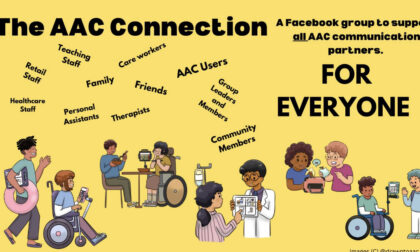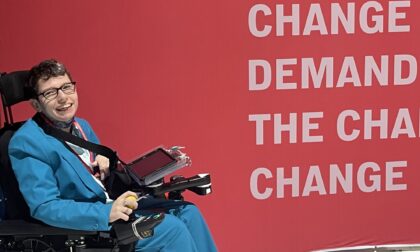First, there was Stephen Hawking, the physicist. Then came Lee Ridley, comedian, also known as ‘Lost Voice Guy’. Now we have Rob Burrow, an ex-rugby league professional and an advocate for motor neurone disease (MND). It is heart-warming to see the mainstream media airtime around using augmentative and alternative communication (AAC) to achieve their goals. Currently, they are lone beacons creating a ripple effect of awareness around themselves.
The general public reaction to seeing and hearing Rob and Lee has been great. They are excellent ambassadors. Due to their media presence, more and more people have a growing awareness of AAC. On the plus side, this is a step in the right direction. They’ve given the AAC community a platform to build on. Now we need to dispel some myths about communication using an AAC device.
Comments received on how high-profile people use AAC
When Lee and Rob speak, they hit a button and the words appear like magic.
True, because they are using pre-programmed speech. They will have spent considerable time preparing what they want to say, inputting it in advance to their device, and then listening back to it to make sure it flows well.
They contribute in real time when asked a question.
True, when they are interviewed, they’ve worked with the interviewer beforehand, and they know the questions they’ll be asked. This means they’ve pre-programmed the answers to the questions, as indicated above, so the words they want to speak are ready to go.
Lee has great timing with his jokes and anecdotes.
True, Lee will have spent hours refining his stories, putting into his pre-programmed speech lots of extra punctuation and pauses for great effect.
Rob’s recent Seven broadcasts on the Total Sport Podcast when he interviewed sporting legends on BBC Sounds was spontaneous and had great flow.
True, the interviews will have been well-edited. Also, take note of the role played by Lindsay in the interviews. Rob asked the main questions and Lindsay added comments, follow-up questions, probed for more information, and kept the interview on topic. Together Rob and Lindsay did a great job demonstrating the strength of their partnership and the supportive role of a communication partner.
What all of this shows is that with good planning, and great communication partners, using AAC can appear effortless and highly spontaneous. And, yet using AAC is not spontaneous
Sadly, spontaneous use of AAC is slow. Most AAC users will have some pre-programmed phrases they use regularly but for anything else, we need to input word by word what we want to say. We may have some short, stored phrases and use of word prediction but we are still constructing each utterance in real time. The ‘box’ does not miraculously speak, instead, we choose/input every utterance that comes out.
Some AAC users are faster than others. Spontaneous speech is usually achieved with patience on behalf of the listener and hard work by the AAC user. When I’m programming a response, it takes me far longer to speak than a verbal speaker who will usually speak between 180 to 240 words per minute (faster if nervous). The maximum I can output spontaneously is around 20 words a minute for novel responses, many people depending on their input method may achieve 1 or 2 words a minute. If I’ve pre-programmed a response or pre-prepared a presentation, then I speak at around 80 to 100 wpm. You can read more about using AAC and speed of output here
Raising awareness around communication partners
So how do we now raise awareness of what great communication partners need to do to empower AAC users? Change comes from bottom-up and top-down processes. Lee and Rob with their celebrity status are leading from the front (top). Currently, I would describe the bottom-up as the ripple effect. By that I mean each individual AAC user is creating an individual concentric circular disturbance around themselves, imagine dropping a pebble into water. Those closest to them are stepping up and becoming great communication partners and advocates. These are their individual families and support networks in schools and the community, who learn either by experience or by in-school training. There will be a stronger ripple where there are groups of AAC users, such as in special schools. But in each scenario the swell or wave gets weaker the further people are from the user.
Developing our future workforce
To my mind, we need now to be engaging our future workforce in developing their communication partner skills. 10% of all children have communication impairments and so do 20% of all adults (RCSLT, 2023). Of course, they don’t all need AAC but being competent communication partners will support the 1 in 200 people who need AAC resources to communicate, and especially the 1 in 2000, like Lee, Rob, and me, who need powered voices to speak. If we get it right for people like us then we get it right for all communicators, whatever their age or disability. But we also improve communication with those who are immigrants or refugees, those with English as a second language, and those experiencing emotional stress and anxiety, or mental health issues. The list is endless because whoever we are we all need communication support at some point in our lives.
In school opportunities
The national curriculum focuses on speaking and listening, yet with some additional thought could also include good communication practices. The national curriculum states “pupils should understand how to take turns and when and how to participate constructively in conversations and debates” (Department for Education, 2023). It is not such a big step to add into this recognising the needs of the listener, and other speakers.
Vocational and professional training
We train students in the skill sets for their future professions but often overlook the importance of human interaction in delivering in their roles. In many institutions, those on key people-facing courses, including teaching, medical and allied health professions, nursing, and social care pathways have limited disability awareness training, and little or no communication disability exposure. Getting this right at the foundation stage will pay dividends throughout a lifetime. Empathetic teachers, doctors, nurses, social workers, and others will feel empowered in their roles to be able to interact not only with AAC users but with anyone needing communication support, including those with English as a second language.
Communication skills are priceless
Good communication basics are priceless when you have a communication impairment, it is a joy to find someone who talks with appropriate communication skills in schools, hospitals, hospitality, retail, and business in general. Using AAC should not make us scary people to talk with. A little training, empathy and patience will unlock the communication potential of us all.
What might you do now?
My challenge is how do you make your operating environment communication accessible and inclusive for everyone, including AAC users?
A start would be to train all staff on the basics of good interactions. This doesn’t just benefit those who are customer-facing. With one-fifth of employees likely to have some form of speech, language and communication need this benefits everyone. The Communication Access UK programme originated in the AAC world and is now focused on supporting all communicators. It’s free to join and receive accreditation. The resources are such that they can easily be delivered as part of induction training and ongoing upskilling of existing staff. See here some of the success stories.
Communication inclusion: the ripple effect
If we can create the ripple effect, not just around communication aid users, but in the wider population then this swell of communication inclusion will benefit those where English is a second language, as well as, people experiencing anxiety and challenging situations, ageing and more. I’d love to see the ripples join and become the new norm for supportive communication for all.





If you found this interesting or
helpful please feel free to share.